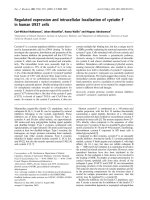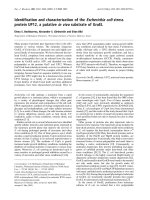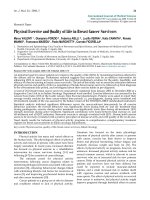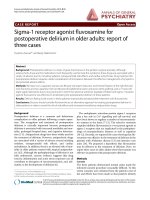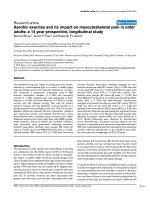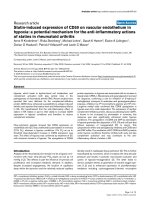Báo cáo y học: "Aerobic exercise and its impact on musculoskeletal pain in older adults: a 14 year prospective, longitudinal study" doc
Bạn đang xem bản rút gọn của tài liệu. Xem và tải ngay bản đầy đủ của tài liệu tại đây (156.31 KB, 8 trang )
Open Access
Available online />R1263
Vol 7 No 6
Research article
Aerobic exercise and its impact on musculoskeletal pain in older
adults: a 14 year prospective, longitudinal study
Bonnie Bruce
1
, James F Fries
1
and Deborah P Lubeck
2
1
Stanford University, Department of Immunology/Rheumatology, Palo Alto, CA 94304, USA
2
Health Economics, Genentech/MS 241A, South San Francisco, CA 94080, USA
Corresponding author: Bonnie Bruce,
Received: 20 May 2005 Revisions requested: 29 Jun 2005 Revisions received: 23 Aug 2005 Accepted: 24 Aug 2005 Published: 19 Sep 2005
Arthritis Research & Therapy 2005, 7:R1263-R1270 (DOI 10.1186/ar1825)
This article is online at: />© 2005 Bruce et al.; licensee BioMed Central Ltd.
This is an Open Access article distributed under the terms of the Creative Commons Attribution License ( />2.0), which permits unrestricted use, distribution, and reproduction in any medium, provided the original work is properly cited.
Abstract
We studied the long term impact of running and other aerobic
exercise on musculoskeletal pain in a cohort of healthy aging
male and female seniors who had been followed for 14 years.
We conducted a prospective, longitudinal study in 866
Runners' Association members (n = 492) and community
controls (n = 374). Subjects were also categorized as Ever-
Runners (n = 565) and Never-Runners (n = 301) to include
runners who had stopped running. Pain was the primary
outcome measure and was assessed in annual surveys on a
double-anchored visual analogue scale (0 to 100; 0 = no pain).
Baseline differences between Runners' Association members
and community controls and between Ever-Runners versus
Never-Runners were compared using chi-square and t-tests.
Statistical adjustments for age, body mass index (BMI), gender,
health behaviors, history of arthritis and comorbid conditions
were performed using generalized estimating equations.
Runner's Association members were younger (62 versus 65
years, p < 0.05), had a lower BMI (22.9 versus 24.2, p < 0.05),
and less arthritis (35% versus 41%, p > 0.05) than community
controls. Runners' Association members averaged far more
exercise minutes per week (314 versus 123, p < 0.05) and miles
run per week (26 versus 2, p < 0.05) and tended to report more
fractures (53% versus 47%, p > 0.05) than controls. Ever-
Runners were younger (62 versus 66 years, p < 0.05), had
lower BMI (23.0 versus 24.3, p < 0.05), and less arthritis (35%
versus 43%, p < 0.05) than Never-Runners. Ever-Runners
averaged more exercise minutes per week (291 versus 120, p <
0.05) and miles run per week (23 versus 1, p < 0.05) and
reported a few more fractures (52% versus 48%, p > 0.05) than
Never-Runners. Exercise was associated with significantly lower
pain scores over time in the Runners' Association group after
adjusting for gender, baseline BMI, and study attrition (p <
0.01). Similar differences were observed for Ever-Runners
versus Never-Runners. Consistent exercise patterns over the
long term in physically active seniors are associated with about
25% less musculoskeletal pain than reported by more sedentary
controls, either by calendar year or by cumulative area-under-
the-curve pain over average ages of 62 to 76 years.
Introduction
The prevalence of older adults in the United States is growing
at a substantial rate. By 2030, nearly one-fifth of Americans
will be in their sixties or older [1], which will have a considera-
ble impact on public health. Numerous epidemiological and
clinical studies have established that older adults who partici-
pate in regular physical activity are healthier and have a better
quality of life than those who are inactive [2-4]. Regular exer-
cise has also been shown to reduce pain in patients with knee
osteoarthritis [5,6] and to help prevent mechanical low back
pain [7]. In contrast, inactivity has been associated with
greater pain with injury and has been associated with lower
bone density and muscle tone [8]. On the other hand, some
aerobic activities, such as running, have been found to result
in increased risk for stress or other fractures [9,10]. Recurring
trauma to soft tissue resulting from excessive physical activity
conceivably could increase pain and disability [11]. Few stud-
ies have addressed the relationship between aerobic exercise
and the perception of pain with advancing age.
To study the effect of exercise on disability and pain, our group
[10] had investigated the relationship of running and its impact
on musculoskeletal pain and disability in cohorts of Runners'
Association members and community controls and Ever-Run-
ners and Never-Runners who were followed prospectively for
six years. In that study, no increase in joint pain or stiffness with
BMI = body mass index; GEE = generalized estimating equations; VAS = visual analog scale.
Arthritis Research & Therapy Vol 7 No 6 Bruce et al.
R1264
age was observed in subjects who exercised often and
intensely compared with their more sedentary counterparts.
Pain was reduced, however, at all time points by about 25% in
the exercising group. In fact, there was a slight decrease in
pain for women who exercised over time.
In this investigation, we have extended that research in those
cohorts. We have evaluated the association of vigorous phys-
ical activity with pain with advancing age after 14 years of fol-
low-up. We hypothesized that those who regularly
participated in running or other aerobic activity would report
less musculoskeletal pain rather than more over the long term
than did their inactive counterparts.
Materials and methods
Subjects
Sample selection and data collection methodology have been
detailed previously [10]. Subjects were drawn from two
groups: the Fifty-Plus Runners' Association with members
across the United States and a Stanford University commu-
nity-based random sample from the Lipid Research Clinics
Study (community controls) which provided access to a sam-
ple that was similar in age to the Runners' Association. In this
analysis, all subjects with at least two annual questionnaires
were included. A total of 961 men and women (538 Runners'
Association members and 423 community controls) who met
eligibility criteria of being at least 50 years old, had at least a
high school education, and used English as their primary lan-
guage were initially enrolled in 1984. A major re-recruitment
effort in 1991 targeted subjects who had dropped out in the
first years of the study. To attenuate self-selection bias and
exercise effects due to the exercisers among the community
controls, we also created groups of Ever-Runners and Never-
Runners based on responses to the question at baseline:
"Have you ever run for exercise for a period greater than one
month?" The study was approved by the Stanford University
Investigational Review Board, and each subject gave their
informed consent.
Data collection
Each subject completed annual, mailed health assessment
questionnaires [12,13]. The questionnaire includes items on
medical history, health status, exercise habits, history of mus-
culoskeletal injuries, health care utilization, and demographic
variables, such as height and weight, smoking, and alcohol
use.
Assessment of physical activity
Physical activity data were obtained from responses to the
question: "How many minutes each week do you exercise vig-
orously (vigorous exercise will cause you to sweat, and your
pulse, if taken, will be above 120). Include periods of rapid
walking at work and in daily activities." Subjects indicated their
participation in running, jogging, swimming, bicycling/station-
ary bike, aerobic dance/exercises, stair steppers, brisk walk-
ing, hiking/treadmill, racket sports, and other.
Assessment of pain
Annually since 1987, pain was assessed using a visual analog
scale (VAS) where 0 = no pain and 100 = worst pain. From
1987 through 1989, subjects responded to the question
"How bad has pain or stiffness been in the past week?" and
marked their response on the VAS. In 1987, the VAS anchors
were: 0 = no pain or stiffness; and 100 = very severe pain or
stiffness. In 1988 and 1989, the VAS anchors were: 0 = no
pain; and 100 = severe pain. Beginning in 1990, a closed-end
stem about the presence or absence of pain was added. If the
patient affirmed they had pain, then they rated their amount of
pain on the VAS. If they responded "No", then their pain score
was assigned a value of zero.
Statistical analysis
Differences between groups at first evaluation (baseline) were
compared using chi-square and t-tests. Results are reported
as mean (SE) or proportion. Longitudinal data were analyzed
using generalized estimating equations (GEE) [14]. Separate
analyses were conducted in which repeated measurements
were coded by calendar year for questionnaire response and
by age. Main-effect predictors were exercise group (Runners'
Association/community controls), gender, baseline age, base-
line body mass index (BMI; kg/m
2
), years of education, number
of hospital days in the past year, and dichotomous variables for
smoking, and history of arthritis, fractures, and cancer at base-
line. Baseline values y
t = 1987
were defined as weighted means
[15],
For all analyses, exercise group and gender were combined to
form a four-level classification factor. Two-way interactions of
each predictor with this classification factor were also
included. To reduce collinearity, each continuous predictor
was dichotomized about its mean. This dichotomization also
produced estimates of gender and exercise group main
effects that were more meaningful.
Four analytic approaches were employed to help reduce the
impact of possible self-selection bias. First, we conducted a
separate analysis by Ever-Runner and Never-Runner classifi-
cation as well as by Runners' Association and community con-
trols groups (from original enrollment). This grouping
expanded the cases to include individuals who self-selected to
run at an earlier age and who stopped running because of pain
or other reasons before entering the study. Second, we used
covariate adjustment to account for baseline differences
between groups. Direct standardization [16] was used to pro-
duce covariate-adjusted mean VAS pain by exercise group
and by study year for statistically significant predictors that
y
yy
t
t
tt
=
+
∈
−1
2
,
Available online />R1265
were identified by the above regression analyses. Data for the
community controls group from the first year that VAS pain
was observed (1987) served as the reference standard. In
addition to providing adjustment for differences on covariates
between Runners' Association and community controls
groups, use of a standard taken at baseline also permitted
adjustment for possible attrition bias. Third, we assessed attri-
tion bias (because any differential attrition between groups
could result in a secondary form of self-selection bias) by per-
forming separate analyses limited to study subjects who com-
pleted all questionnaires in addition to all subjects (completers
versus all). Finally, we used a longitudinal study design in
which an adverse stimulus is expected to eventually result in a
poor outcome regardless of initial self-selection bias if groups
differ sufficiently in exposure to the stimulus. If running creates
damage through accumulated trauma, then runners with about
ten-fold the amount of exposure to such trauma should have
increased pain over time, and any initial differences due to self-
selection should narrow as the study progresses.
Results
In 1987, the first year that VAS pain was assessed, 811 sub-
jects returned questionnaires (458 Runners' Association
members; 353 community controls). The 1991 re-recruitment
efforts increased study enrollment to 881 subjects (496 Run-
ners' Association members; 385 community controls). Fifteen
subjects were excluded from these analyses because classifi-
cation data for Ever-Runner versus Never-Runner were not
available. Over the study duration, subject retention averaged
more than 95% on an annual basis (and 98% of living subjects
each year) as shown in Fig. 1. The mean (SE) years of follow
up for Runners' Association and community controls were
11.4 (0.17) and 10.1 (0.22) (p < 0.05 for difference), respec-
tively, and for Ever-Runners and Never-Runners it was 11.4
(0.16) and 10.5 (0.25) (p < 0.05 for difference), respectively.
Data for this study are based on 866 subjects (492 Runners'
Association and 374 community controls), who were also
grouped as Ever-Runners (n = 565) and as Never-Runners (n
= 301), for whom data were available.
Demographic characteristics at the beginning of the study are
presented for the four study groups in Table 1. Overall, sub-
jects were similarly well educated, but Runners' Association
members and Ever-Runners were statistically younger, had
lower BMI and baseline pain scores, ran more miles, exercised
more minutes per week, and smoked less (all p < 0.05) relative
to community controls and Never-Runners. History of arthritis
was lower in Runners' Association members and Ever-Run-
ners than community controls and Never-Runners, but statisti-
cally significant only for Ever-Runners versus Never-Runners.
In quintiles of baseline exercise minutes/week, less than a
fourth (22%, n = 37) of Ever-Runners and less than a tenth
(7%, n = 12) of Runners' Association members were inactive,
exercising less than 70 minutes a week (data not shown). In
contrast, at the highest quintile, 88% (n = 155) of Runners'
Association members and 91% (n = 159) of the Ever-Runners
exercised between 355 and 2,119 minutes/week, indicating
that subjects in both of these groups were very physically
active. At the end of the study period, the groups had main-
tained similar levels of exercise minutes/week.
Baseline demographic characteristics for the two sets of
groups by gender are shown in Table 2. For both Runners'
Association members and Ever-Runners, the greater majority
of subjects were male (approximately 83%), whereas in com-
munity controls and Never-Runners the sex ratios were more
evenly split (56% and 50%, respectively). In females, Runners'
Association members were younger, weighed less, reported
less pain, fewer hospital days during the past year, ran more
miles and exercised more minutes a week (all p < 0.05) than
Figure 1
Sample size over time for Runners' Association members and community controlsSample size over time for Runners' Association members and community controls.
0
50
100
150
200
250
300
350
400
450
500
1987 88 89 90 91 92 93 94 95 96 97 98 99 2000
Number of Subjects
Runners Association
Community Controls
Arthritis Research & Therapy Vol 7 No 6 Bruce et al.
R1266
Table 1
Baseline characteristics of study groups
Runners' Association (n = 492) Community controls (n = 374) Runners
Ever (n = 565) Never (n = 301)
Male (%) 83 56 84 50
Mean (SE)
Age (years) 61.6 (0.25)
a
65.1 (0.36) 61.7 (0.25)
a
65.6 (0.41)
Education (years) 16.6 (0.11) 16.7 (0.13) 16.7 (0.10) 16.5 (0.15)
BMI (kg/m
2
) 22.9 (0.11)
a
24.2 (0.18) 23.0 (0.11)
a
24.3 (0.21)
Pain (VAS 0–100; 0 = no pain) 20.7 (1.05)
a
25.7 (1.27) 20.4 (0.98)
a
26.6 (1.44)
Hospital days/past year 0.27 (0.05) 0.34 (0.08) 0.24 (0.05) 0.41(0.09)
Running miles (week) 25.5 (0.65)
a
2.1 (0.30) 23.1 (0.64)
a
1.06 (0.29)
Exercise minutes (week) 313.6 (9.2)
a
123.2 (6.8) 290.8 (8.7)
a
119.9 (7.2)
Cigarette (packs/day) 0.02 (0.01)
a
0.08 (0.02) 0.01 (0.01)
a
0.11 (0.02)
Alcohol (oz./day) 1.08 (0.06) 1.22 (0.06) 1.11 (0.05) 1.22 (0.07)
Subjects (%) with history of
Arthritis 35 41 35* 43
Fractures 53 47 52 48
Cancer 0.002 0.005 0.004 0.003
a
p < 0.05 Runners' Association versus community controls or Ever-Runners versus Never-Runners. BMI, body mass index; VAS, visual analog
scale.
Table 2
Baseline characteristics by study group and gender
Runners' Association Community Controls Ever-Runners Never-Runners
Female
(n = 82)
Male
(n = 410)
Female
(n = 163)
Male
(n = 211)
Female
(n = 93)
Male
(n = 472)
Female
(n = 152)
Male
(n = 149)
Mean (SE)
Age (years) 59.9 (0.5)
a
62.0 (0.3)
a
65.5 (0.5) 64.6 (0.5) 60.3 (0.5)
a
62.0 (0.3)
a
65.7 (0.6) 65.5 (0.6)
Education (years) 16.3 (0.3) 16.6 (0.1)
a
15.8 (0.2) 17.5 (0.2) 16.4 (0.3)
a
16.8 (0.1) 15.7 (0.2) 17.3 (0.2)
BMI (kg/m
2
) 21.6 (0.2)
a
23.2 (0.1)
a
23.2 (0.3) 25.0 (0.2) 21.6 (0.2)
a
23.3 (0.1)
a
23.4 (0.3) 25.3 (0.3)
Pain (VAS 0–100; 0 =
no pain)
20.9 (2.6)
a
20.7 (1.2) 27.6 (2.1) 23.0 (1.6) 19.6 (2.4)
a
20.5 (1.1) 28.8 (2.1) 24.3 (1.9)
Hospital days/past year 0.09 (0.1)
a
0.31 (0.1) 0.45 (0.1) 0.25 (0.1) 0.08 (0.0)
a
0.28 (0.1) 0.48 (0.2) 0.33 (0.1)
Running miles (week) 19.4 (1.3)
a
26.9 (0.7)
a
0.99 (0.4) 3.0 (0.4) 17.4 (1.34)
a
24.3 (0.7)
a
0.9 (0.4) 1.3 (0.4)
Exercise minutes (week) 310.8 (19.8)
a
314.2 (10.3)
a
115.8 (10.0) 129.0 (9.1) 283.9 (18.9)
a
292.2 (9.7)
a
118.2 (10.8) 121.6 (9.4)
Cigarette (packs/day) 0.09 (0.04) 0.01 (0.04)
a
0.13 (0.0) 0.05 (0.0) 0.05 (0.0)
a
0.01 (0.0)
a
0.16 (0.0) 0.06 (0.0)
Alcohol (oz./day) 1.0 (0.1) 1.1 (0.1)
a
1.0 (0.8) 1.4 (0.1) 0.98 (0.1) 1.14 (0.1)
a
1.01 (0.1) 1.46 (0.1)
Subjects (%) with history of
Arthritis 45 33 47 36 42 33 49 36
Fractures 54 53 4152 51 52 4254
Cancer 0 0.002 0 0.009 0 0.004 0 0.007
a
p < 0.05 male or female Runners' Association versus matched community controls or male or female Ever-Runners versus matched gender
Never-Runners. BMI, body mass index; VAS, visual analog scale.
Available online />R1267
female community controls. Female Runners' Association
members were also better educated, smoked less, and drank
less alcohol than their community control counterparts (all p >
0.05) and there was a higher proportion of females with a his-
tory of arthritis and a lower proportion of females with a history
of fractures in the community controls and Never-Runners
compared to their counterparts, but these differences were
statistically indistinguishable. Characteristics of male Runners'
Association members versus community controls followed
similar patterns, although differences in VAS pain and hospital
days were not statistically significant, whereas education,
smoking and alcohol were.
Pain scores over time, adjusted for group, gender and baseline
BMI, are presented in Fig. 2 for each study group (Runners'
Association members, community controls, Ever-Runners, and
Never-Runners). The statistically significant covariates, exclud-
ing time and group, were gender (p < 0.01), baseline BMI (p
< 0.01), cigarette packs/day and number of hospital days (p =
0.02). For both comparison groups of runners (Runners' Asso-
ciation and Ever-Runners), pain scores remained significantly
lower over time (p < 0.01) when compared with community
controls or Never-Runners. The dip in scores between 1987
and 1991 is a result of the rephrasing and coding of the pain
question as described earlier. Pain scores were consistently
about 25% less in the exercising group throughout the period
of observation.
Because gender was a significant covariate, pain scores over
time are presented by gender in Fig. 3, adjusted for covariates.
Significant covariates, excluding time and group, are fracture
in past year (p = 0.026) and the presence of arthritis (p <
0.001). As observed previously, community controls have
more pain over time; however, female controls have the great-
est self-reported pain, with female and male controls reporting
significantly more pain than either female runners (p = 0.048)
or male runners (p = 0.004). Similar results were observed for
VAS pain scores by gender for Never-Runners and Ever-Run-
ners (data not shown).
To evaluate the impact of study attrition and the possibility that
withdrawal from the study might be associated with increased
pain, we repeated the analyses by group and gender for study
completers only. There were 61 female runners, 253 male run-
ners, 84 female community controls and 116 male community
controls who completed all questionnaires. In addition to time,
group, and gender, presence of arthritis (p < 0.001) and edu-
cation years (p = 0.036) were significant covariates. Similar to
results of analyses using all available data, reduced levels of
pain for male and female runners were observed in compl-
eters, although the only statistically significant difference over
time is between female runners and male and female controls
(p < 0.05).
Our final analyses tested the extent to which exercise and pain
were affected by increasing age (Fig. 4). As in previous analy-
ses, a history of arthritis and fractures were significant covari-
ates (p < 0.001). There were significant increases in pain
scores for female and male community controls and runners
with increasing age, although the rates of increase are rela-
tively modest. Older female runners tended to have the great-
est beneficial impact, although these associations were
statistically equivalent to differences in male runners and con-
trols (p = 0.51).
Figure 2
Adjusted mean visual analog scale pain scores over time by study groupAdjusted mean visual analog scale pain scores over time by study group. For both comparison groups of runners (Runners' Association members
and Ever-Runners), pain scores remained significantly lower over time (p < 0.01) when compared with community controls or Never-Runners.
0
5
10
15
20
25
30
1987 88 89 90 91 92 93 94 95 96 97 98 99 2000
Pain Score
Runners Association
Community Controls
Ever Runners
Never Runners
Arthritis Research & Therapy Vol 7 No 6 Bruce et al.
R1268
Discussion
This paper addresses the issue as to whether consistent vig-
orous exercise patterns over the long term are associated with
greater or reduced musculoskeletal pain. In these cohorts, run-
ners had substantially reduced pain levels compared with con-
trols, which persisted over average ages of 62 to 76 years.
Exercise was associated with a substantial and significant
reduction in pain even after adjusting for gender, baseline BMI
Figure 3
Adjusted mean visual analog scale pain scores over time by gender and study groupAdjusted mean visual analog scale pain scores over time by gender and study group. After adjusting for covariates, the community controls have
more pain over time; however, female controls have the greatest self-reported pain, with female and male controls reporting significantly more pain
than either female runners (p = 0.0048) or male runners (p = 0.004).
Figure 4
Adjusted mean visual analog scale pain scores by age, gender and study groupAdjusted mean visual analog scale pain scores by age, gender and study group. Significant increases in pain scores for female and male community
controls and runners were found with increasing age, although rates of increase are relatively modest. Older female runners tend to have the great-
est benefit, although these associations are statistically equivalent to differences in male and female runners and controls (p = 0.51).
0
5
10
15
20
25
30
35
1987 88 89 90 91 92 93 94 95 96 97 98 99 2000
Pain Score
Female Runners Association
Male Runners Association
Female Community Controls
Male Commmunity Controls
0
5
10
15
20
25
30
35
55 60 65 70 75 80
Pain Scor
e
Female Runners Association
Male Runners Association
Female Community Controls
Male Community Controls
Years of Age
Available online />R1269
and attrition, and despite the fact that fractures, a significant
predictor of pain, were slightly more common among runners.
This relationship held as well when study completers only
were evaluated.
Previous studies have indicated that men and women can dif-
fer in levels of self-reported pain and its importance [17-20]. In
this study, male community controls reported less pain than
their female counterparts. Female community controls and
Never-Runners tended to report the highest levels of pain on
average, whereas female runners appeared to receive the
greatest benefit in reduced pain.
This study does not provide insight into the mechanisms that
might underlie these results, although we have previously ruled
out self-report bias between runners and non-runners by
differential validation against spousal values [21]. A trend
toward more frequent reports of a history of arthritis in controls
could have played a role; fractures, however, were more com-
mon in runners and should have worked in the opposite direc-
tion. Other possible mechanisms include endorphin release,
exercise protection against secondary fibromyalgia, increased
resistance to musculoskeletal micro-injury, psychologically
based increase in pain threshold, innately high pain threshold
influencing decision to exercise vigorously, or other psycho-
logical mechanisms.
Musculoskeletal pain has also been shown to be associated
with disability in older individuals and individuals with some
chronic diseases [22,23]. But in a study of persons with rheu-
matoid arthritis, Ward and Leigh [22] noted that pain was a
larger contributor to measurement of overall health status than
physical disability and among both older male and female indi-
viduals. Leveille and colleagues [23] evaluated the presence
of pain in women over 65 years of age and observed wide-
spread musculoskeletal pain.
Conclusion
The primary finding from this investigation is that while pain
does increase with age in subjects in all study groups, there
was no progressive increase in musculoskeletal pain in older
adults who participated in regular vigorous exercise, including
running, compared with those who did not. Initial differences
favoring exercisers were shown to be maintained over time. As
pain and disability are linked, our findings add to the evidence
that morbidity associated with aging can be reduced by partic-
ipating in regular aerobic activity.
Competing interests
The authors declare that they have no competing interests.
Authors' contributions
BB performed statistical analyses, interpretation of data, and
drafting of the manuscript; JFF participated in study design,
interpretation of data, and drafting of the manuscript; DL par-
ticipated in study design, statistical analyses, interpretation of
data, and drafting of the manuscript. All authors have read and
approved the final manuscript.
Acknowledgements
This research was supported by a grant from the National Institutes of
Health (5R01-AG15815) to Stanford University, Department of Immu-
nology/Rheumatology (JFF, Principal Investigator).
References
1. Centers for Disease Control and Prevention (CDC): Trends in
aging: United States and worldwide. MMWR Morb Mortal Wkly
Rep 2003, 52:101-104.
2. Centers for Disease Control: The State of Aging and Health in
America Washington: Merck Institute of Aging and Health; 2004.
3. Macera CA, Hootman JM, Sniezek JE: Major public health bene-
fits of physical activity. Arthritis Rheum 2003, 49:122-128.
4. Pate RR, Pratt M, Blair SN, Haskell WL, Macera CA, Bouchard C,
Buchner D, Ettinger W, Heath GW, King AC, et al.: Physical activ-
ity and public health. A recommendation from the Centers for
Disease Control and Prevention and the American College of
Sports Medicine. JAMA 1995, 273:402-407.
5. Brady TJ, Kruger J, Helmick CG, Callahan LF, Boutaugh ML: Inter-
vention programs for arthritis and other rheumatic diseases.
Health Educ Behav 2003, 30:44-63.
6. Ettinger WH Jr, Burns R, Messier SP, Applegate W, Rejeski WJ,
Morgan T, Shumaker S, Berry MJ, O'Toole M, Monu J, Craven T: A
randomized trial comparing aerobic exercise and resistance
exercise with a health education program in older adults with
knee osteoarthritis. The Fitness Arthritis and Seniors Trial
(FAST). JAMA 1997, 277:25-31.
7. Vuori I: Exercise and physical health: musculoskeletal health
and functional capabilities. Res Q Exerc Sport 1995,
66:276-285.
8. Taimela S, Diederich C, Hubsch M, Heinricy M: The role of phys-
ical exercise and inactivity in pain recurrence and absenteeism
from work after active outpatient rehabilitation for recurrent or
chronic low back pain: a follow-up study. Spine 2000,
25:1809-1816.
9. Daffner RH, Martinez S, Gehweiler JA: Stress fractures in
runners. JAMA 1982, 247:1039-1041.
10. Fries JF, Singh G, Morfeld D, O'Driscoll P, Hubert H: Relationship
of running to musculoskeletal pain with age. A six-year longi-
tudinal study. Arthritis Rheum 1996, 39:64-72.
11. McAlindon TE, Cooper C, Kirwan JR, Dieppe PA: Determinants of
disability in osteoarthritis of the knee. Ann Rheum Dis 1993,
52:258-262.
12. Fries JF, Spitz P, Kraines RG, Holman HR: Measurement of
patient outcome in arthritis. Arthritis Rheum 1980, 23:137-145.
13. Bruce B, Fries J: The Stanford health assessment question-
naire (HAQ): a review of its history, issues, progress, and
documentation. J Rheumatol 2003, 30:167-178.
14. Liang KY, Zeger SL: Longitudinal data analysis using general-
ized linear models. Biometrika 1986, 73:13-22.
15. Sen A, Srivastava M: Regression Analysis: Theory, Method and
Application New York: Springer-Verlag; 1990.
16. Rosner B: Fundamentals of Biostatistics Belmont, CA:
Wadsworth Publishing Co; 1995.
17. Herr KA, Garand L: Assessment and measurement of pain in
older adults. Clin Geriatr Med 2001, 17:457-478.
18. Kelly AM: Does the clinically significant difference in visual
analog scale pain scores vary with gender, age, or cause of
pain? Acad Emerg Med 1998, 5:1086-1090.
19. Unruh AM: Gender variations in clinical pain experience. Pain
1996, 65:123-167.
20. Unruh AM, Ritchie J, Merskey H: Does gender affect appraisal of
pain and pain coping strategies? Clin J Pain 1999, 15:31-40.
21. Fries JF, Singh G, Morfeld D, O'Driscoll P, Hubert H: Relationship
of running to musculoskeletal pain with age. A six-year longi-
tudinal study. Arthritis Rheum 1996, 39:64-72.
22. Ward MM, Leigh JP: The relative importance of pain and func-
tional disability to patients with rheumatoid arthritis. J
Rheumatol 1993, 20:1494-1499.
Arthritis Research & Therapy Vol 7 No 6 Bruce et al.
R1270
23. Leveille SG, Ling S, Hochberg MC, Resnick HE, Bandeen-Roche
KJ, Won A, Guralnik JM: Widespread musculoskeletal pain and
the progression of disability in older disabled women. Ann
Intern Med 2001, 135:1038-1046.
